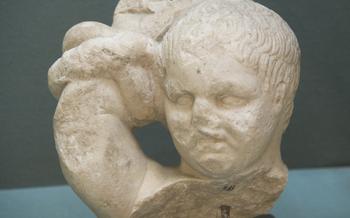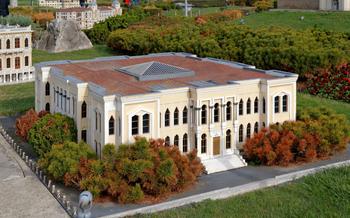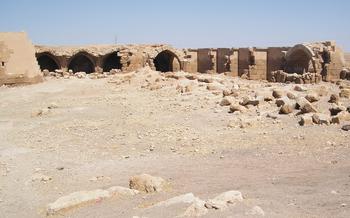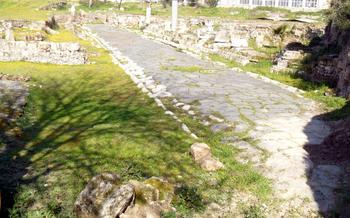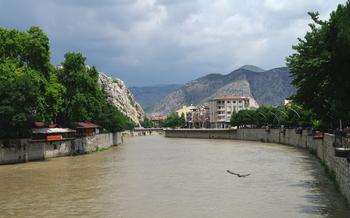
Kahramanmaraş Historical Water Cisterns
- A Journey to Kahramanmaraş's Water Cisterns
- A Labyrinth of History: Unraveling the Past
- Engineering Marvels: A Showcase of Ancient Ingenuity
- A Walk Through Time: Exploring the Cisterns' Depths
- Echoes of History: Tales from the Cisterns
- A Sanctuary of Serenity: Finding Tranquility Amidst History
- The Cisterns in Art and Literature: Immortalized in Various Forms
- Preservation and Restoration: Safeguarding a Historical Treasure
- The Cisterns in the Eyes of Locals: A Source of Pride and Identity
- A Glimpse into the City's Past: Unearthing Ancient Treasures
- A Destination for History Buffs and Architecture Enthusiasts
- The Cisterns in the Spotlight: A Venue for Events and Exhibitions
- A Place for Photography and Artistic Inspiration
- Accessibility and Amenities: Planning Your Visit
- Insider Tip: Unveiling Hidden Secrets
A Journey to Kahramanmaraş's Water Cisterns
Historical Background:
The cisterns in Kahramanmaraş stand as testaments to the city's rich history. Built during the Roman era, these underground reservoirs played a vital role in ensuring a reliable water supply for the city's inhabitants. Over the centuries, the cisterns underwent modifications and expansions, reflecting the influence of various civilizations that ruled the region. The Seljuks and Ottomans left their mark on the cisterns, adding architectural features that showcased their unique styles. Today, these cisterns stand as remarkable examples of ancient engineering prowess and serve as a glimpse into the city's past.
Importance of the Cisterns for the City:
The cisterns were integral to Kahramanmaraş's survival and prosperity. In a region known for its dry climate, these reservoirs provided a dependable source of water for the city's growing population. The cisterns' ability to store vast quantities of water ensured that the city had a steady supply during droughts or times of conflict. They also played a crucial role in supporting agricultural activities in the surrounding areas, contributing to the city's economic development.
Unique Architectural Features:
The Kahramanmaraş cisterns are renowned for their exceptional architectural design. Constructed using a combination of stone and brick, the cisterns showcase impressive arched ceilings and intricate vaulted structures. The walls are lined with waterproof plaster, a testament to the advanced construction techniques of the time. The cisterns are divided into multiple chambers, each supported by rows of columns and pillars. These architectural elements not only provide structural stability but also create a visually stunning interior space that echoes with history.
How to Reach the Cisterns:
The Kahramanmaraş cisterns are conveniently located in the heart of the city, making them easily accessible to visitors. Situated near the bustling city center, the cisterns are a short walk from various historical sites, museums, and shopping areas. Visitors can easily reach the cisterns by foot, public transportation, or taxi. Guided tours are available for those who wish to delve deeper into the cisterns' history and significance.
A Labyrinth of History: Unraveling the Past
The Kahramanmaraş Historical Water Cisterns have stood as silent witnesses to the city's rich and storied history. In the Roman era, they served as vital reservoirs, ensuring a steady water supply for the flourishing city. The Romans, known for their engineering prowess, constructed these cisterns with meticulous care, employing advanced techniques that ensured their longevity.
As the Byzantine Empire spread its influence over the region, the cisterns continued to play a crucial role. The Byzantines, with their emphasis on urban planning and infrastructure, recognized the importance of these water reserves and maintained them diligently. The cisterns became an integral part of the city's water management system, contributing to its resilience and prosperity.
The arrival of the Seljuk and Ottoman empires brought new layers of history to Kahramanmaraş. The Seljuks, with their architectural innovations, added decorative elements to the cisterns, enhancing their aesthetic appeal. The Ottomans, who ruled for centuries, continued to utilize the cisterns, ensuring their preservation and functionality.
In modern times, the cisterns have transcended their original purpose and emerged as a significant tourist attraction. Visitors from around the world flock to witness these subterranean marvels, which stand as a testament to the ingenuity and resilience of past civilizations. The cisterns have become a symbol of Kahramanmaraş's rich heritage, attracting history buffs, architecture enthusiasts, and travelers seeking a glimpse into the city's storied past.
Engineering Marvels: A Showcase of Ancient Ingenuity
The Kahramanmaraş Historical Water Cisterns stand as a testament to the engineering prowess of ancient civilizations. Constructed using meticulous techniques and durable materials, these cisterns served as a vital water storage and distribution system for the city. The builders employed a combination of stone, brick, and mortar to create sturdy structures that have withstood the test of time.
The cisterns' water filtration system was a marvel of its time. Water from nearby springs and rivers was channeled into the cisterns through a series of underground aqueducts. As the water flowed through the cisterns, it passed through layers of gravel and sand, which effectively filtered out impurities and sediment. This filtration process ensured a clean and reliable water supply for the city's inhabitants.
The cisterns also incorporated innovative architectural features to ensure efficient water storage and distribution. The domed roofs of the cisterns helped to prevent evaporation and maintain a cool and humid environment, minimizing water loss. The cisterns were also divided into multiple chambers, allowing for the storage of large volumes of water without compromising structural stability.
These engineering marvels not only provided a vital water source for the city but also showcased the ingenuity and forward-thinking of ancient civilizations. The cisterns' construction techniques and design principles continue to inspire modern engineers and architects, demonstrating the enduring legacy of these ancient water management systems.
A Walk Through Time: Exploring the Cisterns' Depths
As you descend into the depths of the cisterns, a palpable sense of awe and wonder envelops you. The massive stone columns, towering overhead, create an atmosphere of grandeur and antiquity. The air is cool and damp, carrying with it the faint scent of history. The cisterns' unique acoustics amplify every footstep and whisper, creating an ethereal ambiance that transports you back in time.
As you wander through the labyrinthine network of chambers and corridors, you'll discover a treasure trove of architectural wonders. Intricate carvings adorn the walls, telling tales of forgotten civilizations and bygone eras. The cisterns' ingenious water filtration and storage systems, once essential for the city's survival, stand as testaments to the engineering prowess of ancient civilizations.
The cisterns are not merely a historical relic; they are a living testament to the enduring spirit of Kahramanmaraş. Today, they serve as a popular tourist attraction, drawing visitors from far and wide who come to marvel at their grandeur and learn about their rich history.
Plan to spend at least an hour exploring the cisterns and soaking in their unique atmosphere. The cisterns are open to the public daily, and admission fees are minimal. Guided tours are available for those who want to delve deeper into the cisterns' history and significance.
Whether you're a history buff, an architecture enthusiast, or simply someone who appreciates the beauty of ancient engineering, the Kahramanmaraş Historical Water Cisterns are an absolute must-see. Their timeless allure and rich heritage make them one of the city's most captivating attractions.
Echoes of History: Tales from the Cisterns
The Kahramanmaraş Historical Water Cisterns have inspired a rich tapestry of legends, stories, and folklore that have been passed down through generations. Locals believe that the cisterns are home to benevolent spirits who protect the city and its people. One popular legend tells the story of a young girl who fell into one of the cisterns and was rescued by a mysterious figure who emerged from the water. In gratitude, the girl's family built a small shrine near the cistern to honor the spirit's kindness.
Another tale speaks of a hidden treasure buried beneath the cisterns, said to be the lost wealth of an ancient king. According to legend, the treasure is guarded by a fierce dragon that only appears to those who are pure of heart. Over the years, many have tried to claim the treasure, but none have succeeded, as the dragon has proven to be an insurmountable guardian.
These legends and stories have become an integral part of the cisterns' allure, adding a touch of mystery and enchantment to their already captivating atmosphere. They serve as a testament to the cisterns' deep connection to the city's cultural heritage and the enduring power of storytelling.
A Sanctuary of Serenity: Finding Tranquility Amidst History
The Kahramanmaraş Historical Water Cisterns stand as a testament to the city's rich history and engineering prowess. However, beyond their historical significance, the cisterns offer visitors a unique opportunity to escape the hustle and bustle of modern life and find solace in the depths of history.
As you descend into the subterranean chambers, a sense of tranquility envelops you. The cool, damp air and the soft echoes of dripping water create a calming atmosphere that invites reflection and relaxation. The cisterns' vastness and intricate architecture evoke a sense of awe and wonder, reminding visitors of the ingenuity and perseverance of those who built them centuries ago.
The cisterns' unique acoustics and natural lighting contribute to their serene ambiance. The gentle sound of water droplets reverberates through the chambers, creating a soothing melody that lulls visitors into a state of tranquility. The cisterns' vaulted ceilings and arched niches allow natural light to filter in, casting soft shadows and illuminating the intricate details of the stonework.
Stepping into the cisterns is like stepping back in time, away from the distractions and stresses of modern life. Here, visitors can find a sanctuary of serenity, a place to reconnect with their inner selves and appreciate the beauty and tranquility of a bygone era. Whether you choose to sit quietly and soak in the atmosphere or wander through the chambers, marveling at the engineering feats of the past, the cisterns offer a unique and unforgettable experience that will leave you feeling refreshed and rejuvenated.
The Cisterns in Art and Literature: Immortalized in Various Forms
The Kahramanmaraş Historical Water Cisterns have captured the imagination of local artists and writers, inspiring a variety of creative expressions. These cisterns have been depicted in local paintings, sculptures, and poems, each offering a unique interpretation of their historical significance and architectural beauty.
One notable painting is "Cisterns of Kahramanmaraş" by local artist Mehmet Ali Çelebi. This oil on canvas masterpiece portrays the cisterns in a warm, golden light, highlighting the intricate details of the vaulted ceilings and the water's serene reflection. The painting captures the cistern's timelessness and evokes a sense of awe and wonder.
Another captivating work is the sculpture "The Guardian of the Cisterns" by renowned sculptor Ayşe Gül Erdem. Carved from a single block of marble, the sculpture depicts a mythical creature with the body of a lion and the head of an eagle, symbolizing the strength and vigilance with which the cisterns have stood the test of time. The sculpture stands as a testament to the enduring legacy of these ancient structures.
In the realm of literature, the cisterns have served as a muse for local poets and writers. The cisterns' mysterious atmosphere and historical significance have inspired countless poems, short stories, and even novels. One such work is the poem "Whispers of the Cisterns" by local poet Aylin Yılmaz. Her words capture the echoes of history that linger within the cisterns' walls, weaving a tale of love, loss, and the enduring spirit of the city.
Preservation and Restoration: Safeguarding a Historical Treasure
The Kahramanmaraş Historical Water Cisterns, standing as testaments to the city's rich past, are not immune to the ravages of time. Recognizing their immense historical and cultural value, ongoing efforts are underway to preserve and restore these ancient structures. Local and international organizations, working in collaboration, are dedicated to ensuring that these cisterns remain a source of pride and inspiration for generations to come.
Preservation efforts focus on maintaining the cisterns' structural integrity, addressing issues such as water seepage, erosion, and damage caused by natural disasters. Restoration work involves cleaning and repairing the cisterns' interior surfaces, restoring original architectural features, and implementing measures to improve accessibility for visitors.
Challenges in preserving the cisterns include limited funding, the need for specialized expertise, and the ongoing risk of damage from environmental factors. Despite these challenges, progress is being made, and the cisterns are gradually regaining their former glory.
Visitors to the cisterns can contribute to preservation efforts by adhering to designated pathways, refraining from touching or damaging the structures, and reporting any signs of deterioration to the authorities. Supporting local organizations involved in conservation work is another meaningful way to contribute to the preservation of this priceless heritage.
The Cisterns in the Eyes of Locals: A Source of Pride and Identity
To the people of Kahramanmaraş, the cisterns are more than just a historical site; they are a symbol of their city's rich past and a source of immense pride. The cisterns are deeply ingrained in the city's identity and shape its sense of place. Locals take great pride in showcasing this unique heritage to visitors and often share stories and legends associated with the cisterns. Local initiatives, such as guided tours led by community members, aim to promote and celebrate the cisterns, fostering a sense of community spirit and unity among the residents. The cisterns serve as a reminder of the city's resilience and the ingenuity of its ancestors, strengthening the bond between the people of Kahramanmaraş and their heritage.
A Glimpse into the City's Past: Unearthing Ancient Treasures
The cisterns have yielded a wealth of archaeological discoveries, shedding light on Kahramanmaraş's rich history. During excavations, archaeologists unearthed numerous artifacts, including pottery fragments, coins, and tools. These artifacts provide valuable insights into the daily lives and customs of the city's ancient inhabitants.
Additionally, the cisterns themselves hold clues about the city's past. The construction techniques, materials, and modifications made over the centuries offer a glimpse into the city's architectural evolution and the influence of different civilizations. By studying the cisterns, historians and archaeologists can piece together the story of Kahramanmaraş's development from a small settlement to a thriving urban center.
The cisterns serve as a tangible link to the city's past, allowing visitors to connect with the people who lived and worked here centuries ago. They offer a unique opportunity to explore the layers of history that make Kahramanmaraş such a fascinating and culturally rich destination.
A Destination for History Buffs and Architecture Enthusiasts
Kahramanmaraş is a city teeming with historical and architectural treasures, and the cisterns stand as one of its most captivating attractions. History buffs and architecture enthusiasts will find themselves enthralled by these ancient reservoirs, which offer a glimpse into the city's rich past and its remarkable engineering prowess. The cisterns' unique design, intricate construction, and historical significance make them a must-see for anyone seeking to delve deeper into Kahramanmaraş's heritage.
Beyond the cisterns, visitors can embark on a journey through time as they explore other historical landmarks in the vicinity. The city is home to numerous mosques, churches, and caravanserais, each with its own unique story to tell. The Kahramanmaraş Castle, perched atop a hill overlooking the city, offers breathtaking views and a chance to immerse oneself in the city's military history.
For those seeking a comprehensive exploration of Kahramanmaraş's historical and architectural treasures, a history-themed itinerary is a must. Visitors can start their journey at the cisterns, then continue on to the castle, the Grand Mosque, and the various other historical sites scattered throughout the city. Along the way, they will discover the stories of the people who shaped Kahramanmaraş's past and gain a deeper appreciation for the city's enduring legacy.
The Cisterns in the Spotlight: A Venue for Events and Exhibitions
Kahramanmaraş's historical water cisterns have transformed into a captivating venue for events and exhibitions, attracting visitors with their unique and atmospheric setting. The cisterns' vaulted ceilings, stone arches, and echoing acoustics create an immersive ambiance that enhances any event. The spacious interior can accommodate a variety of events, including concerts, art exhibitions, fashion shows, and cultural performances.
The cisterns' versatility allows for a diverse range of events. The acoustics are ideal for musical performances, creating an intimate and resonant atmosphere. Art exhibitions find a perfect backdrop in the cisterns' ancient walls, where sculptures, paintings, and installations come alive amidst the historical surroundings. Fashion shows take on a dramatic flair as models showcase their creations against the backdrop of centuries-old architecture.
Notable events held at the cisterns have included concerts by renowned musicians, art exhibitions by local and international artists, and historical reenactments that bring the cisterns' past to life. These events attract visitors from across the region, eager to experience the unique combination of history and culture within the cisterns' walls.
A Place for Photography and Artistic Inspiration
The Kahramanmaraş Historical Water Cisterns, with their captivating blend of history, architecture, and atmosphere, have become a haven for photography enthusiasts and artistic souls. The unique setting of the cisterns, with their vaulted ceilings, intricate arches, and play of light and shadow, presents a treasure trove of photographic opportunities. Whether you're a seasoned professional or an amateur with a passion for capturing stunning images, the cisterns offer a canvas that will ignite your creativity.
The cisterns' vast, open spaces and intricate details make them ideal for wide-angle shots that showcase the scale and grandeur of the architecture. Experiment with different perspectives and compositions to capture the cisterns' unique ambiance. Look for interesting angles that highlight the interplay of light and shadow, creating dramatic silhouettes and enchanting reflections.
Macro photography enthusiasts will find endless subjects within the cisterns. The weathered stone walls, intricate carvings, and ancient inscriptions offer a wealth of close-up opportunities. Capture the textures, patterns, and hidden details that tell the story of the cisterns' rich history.
The cisterns' unique acoustics and natural lighting also make them a popular spot for sound artists and filmmakers. The reverberant qualities of the space create a captivating soundscape that can be incorporated into immersive audio experiences. Filmmakers are drawn to the cisterns for their atmospheric setting, which provides a backdrop for evocative historical dramas, fantasy films, and music videos.
Beyond their visual and auditory appeal, the cisterns have also inspired artists in other mediums. Local painters, sculptors, and poets have found endless inspiration in the cisterns' mystique, creating works of art that capture their essence and evoke their timeless spirit.
Whether you're a photographer, filmmaker, sound artist, or simply someone with an appreciation for beauty, the Kahramanmaraş Historical Water Cisterns offer a feast for the senses and a spark for your creativity. Embrace the cisterns' magic and let your artistic vision soar.
Accessibility and Amenities: Planning Your Visit
The Kahramanmaraş Historical Water Cisterns are accessible to visitors of all abilities. Ramps and elevators provide easy access for those with limited mobility. Once inside, the cisterns are well-lit and have designated pathways for safe exploration.
For the convenience of visitors, restrooms, a small café, and a gift shop are available on-site. The café offers a selection of refreshments and light snacks, while the gift shop sells souvenirs and informational materials related to the cisterns.
To ensure a pleasant visit, plan your visit during the cooler hours of the day, as the cisterns can be quite humid and warm. Admission fees are minimal, and discounts are available for students, seniors, and groups.
Check the official website of the Kahramanmaraş Historical Water Cisterns or contact the local tourism office for the most up-to-date information on accessibility, amenities, admission fees, and guided tour schedules.
Insider Tip: Unveiling Hidden Secrets
Beyond the main tourist routes, the cisterns hold hidden corners and untold stories. One lesser-known secret is the "Echoing Chamber." Located in the deepest part of the complex, this chamber boasts remarkable acoustics. Whisper a word, and it reverberates throughout the space, creating an enchanting and almost ethereal atmosphere.
For a unique perspective, venture to the upper levels of the cisterns. There, you'll find a hidden passageway that leads to a secluded balcony overlooking the main chamber. From this vantage point, you can marvel at the intricate architecture and capture breathtaking photographs of the cisterns in all their glory.
To make the most of your visit, consider exploring the cisterns at different times of the day. While daytime offers clear views, nighttime illumination transforms the cisterns into a magical realm. The soft glow of the lights dances on the water's surface, creating a mesmerizing ambiance that will leave you spellbound.
